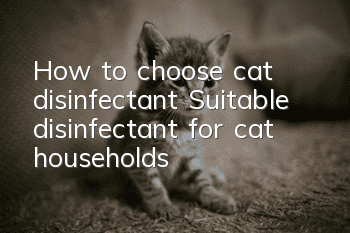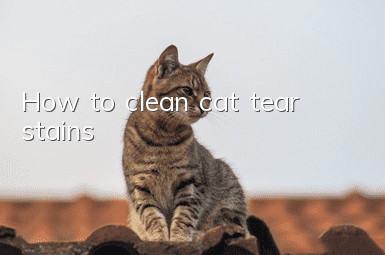How to choose cat disinfectant? Suitable disinfectant for cat households!

I think for every cat-loving parent, the health of cats is crucial. Disinfection of cat supplies, toys and the environment is an important way to prevent feline infectious diseases and diseases common to humans and cats. Many parents are confused about the frequency of disinfection, disinfection methods and the choice of disinfection supplies. More and more disinfection supplies for humans and pets are flooding the market, and the good and bad are mixed, which often makes it difficult for everyone to know where to start.
In order to prevent cats from contracting serious diseases due to viruses, bacteria or fungi existing in the environment, disinfection has become particularly important. So how to choose cat disinfectant? Next, let’s follow the editor to learn about disinfection suitable for cat households. liquid.
How to choose cat disinfectant?
In order to prevent cats and family members from getting sick, the editor recommends a sterilizing and disinfecting spray that can sterilize and disinfect and is safe and harmless to human pets - Aineng Pet Sterilizing and Disinfecting Liquid Spray.
It can destroy a variety of common bacteria. It only takes 15-30 seconds to kill 99.99% of E. coli, spore bacteria, tuberculosis bacteria, etc. and influenza viruses.
It is effective after just a few sprays. It is safe and non-irritating. You can eat directly after spraying your hands. It can also be used to disinfect wounds, pets, toys and daily necessities. The liquid sprayed by Aineng Pet Sterilization and Disinfection Spray is atomized and basically odorless. You can only smell a very light smell when you are close to it, and it disappears in a few seconds. Moreover, it can also remove odors and can be used directly as an air freshener to remove various odors in the house and car.
How often should homes be disinfected?
In fact, the frequency of disinfection depends on the condition of the cat’s mouth at home. Under normal circumstances, in households with 1-2 cats, it is recommended that parents disinfect cat supplies and the environment (including drinking water utensils, toys, toilets, nest mats or cages) every week if there is no outbreak of feline infectious disease. The frequency of disinfection in multi-cat households should be increased, preferably twice a week or once every two days. The scope of disinfection should also be expanded to the floor, sofas and even slippers where cats often lie. Home breeders, on the other hand, should develop more stringent disinfection procedures. Because breeders often not only have a large population of cats, but also often have kittens with weak immunity at home.
How should various items and environments be disinfected?
① Drinking utensils, toys and toilets
Remaining cat food and litter should be discarded, and utensils and toys should be cleaned thoroughly. And soak in disinfectant water of appropriate concentration for more than 10 minutes, and then rinse with clean water.
② Cat facilities and household facilities
ForFacilities such as cat climbing frames should be wiped clean with clean water, and then sprayed and wiped with a disinfectant of appropriate concentration. Finally, clean water should be used to wipe off the disinfectant residue.
It should be noted that fabrics (such as climbing frames, sofa cushions, cat nests and cat scratching boards) are the most difficult to clean. It is difficult to remove microorganisms (such as fungal spores) hidden inside by simply spraying disinfectant. This requires Soak in disinfectant or boiling water.
③ Disinfection of home environment
The floor should be wiped with a disinfectant solution of appropriate concentration, and then wiped clean with clean water. For the disinfection of air and environment, the role of spraying disinfectant is not obvious. Environmental disinfection equipment is mainly recommended. Ultraviolet lamps and ozone generators are good choices.
- Why do cats protect their food? How to protect cats’ food?
- Can cats eat watermelon?
- What's going on with the black spots around the cat's mouth?
- Cat vomits and refuses to eat food, but is in good spirits?
- Why does the cat at home keep meowing?
- How to deworm a cat? Cat deworming guide!
- How will cats react to an earthquake?
- Do cats remember their owners’ faces?
- What should I do if my white cat is anemic? What is the best thing for white cats to eat when they are anemic?
- Six types of cats that are good-looking, cheap and easy to keep



